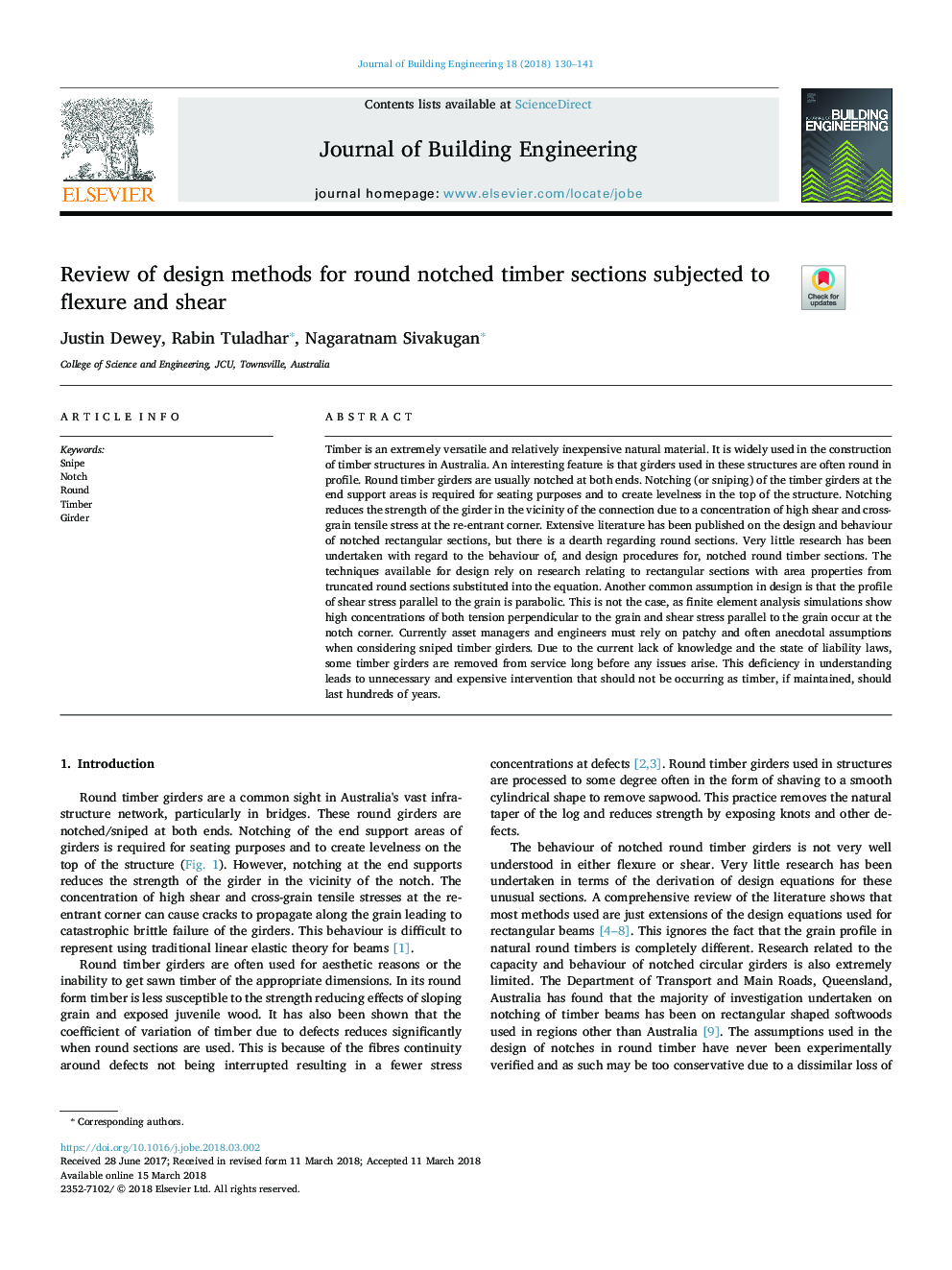| کد مقاله | کد نشریه | سال انتشار | مقاله انگلیسی | نسخه تمام متن |
|---|---|---|---|---|
| 6749859 | 1430630 | 2018 | 12 صفحه PDF | دانلود رایگان |
عنوان انگلیسی مقاله ISI
Review of design methods for round notched timber sections subjected to flexure and shear
ترجمه فارسی عنوان
بررسی روش های طراحی برای مقاطع چوبی دندانه دار تحت خمش و برش
دانلود مقاله + سفارش ترجمه
دانلود مقاله ISI انگلیسی
رایگان برای ایرانیان
کلمات کلیدی
اسنایپ، نکته دور چوب تیر اهن،
ترجمه چکیده
چوب یک ماده طبیعی بسیار متنوع و نسبتا ارزان است. این است که به طور گسترده ای در ساخت سازه های چوبی در استرالیا استفاده می شود. یکی از ویژگی های جالب این است که کمربند هایی که در این سازه ها استفاده می شود اغلب در نمایه های مختلف هستند. پنل های چوب گرد معمولا در هر دو انتها قرار می گیرند. برداشتن (یا تکه تکه کردن) تیرهای چوبی در قسمتهای حمایت از پایان لازم است برای اهداف صندلی و ایجاد سطح در بالای ساختار مورد نیاز است. برش باعث کاهش نیروی محوری در مجاورت اتصال می شود به علت غلظت برشی بالا و استحکام کششی متقابل دانه در گوشه ای که تازه وارد شده است. ادبیات گسترده ای در مورد طراحی و رفتار بخش های مستطیلی نشخوار منتشر شده است، اما در مورد بخش های دور وجود دارد. تحقیقات بسیار کمی در رابطه با رفتار و روش های طراحی برای بخش های مقطع چوب گرد شده صورت گرفته است. تکنیک های موجود برای طراحی بر روی تحقیقات مربوط به بخش های مستطیلی با خواص سطح از مقاطع دور کوتاه تعویض به معادله تکیه می کنند. یکی دیگر از معمولی در طراحی این است که مشخصات تنش برشی موازی با دانه، پارابولیک است. این مورد نیست، زیرا شبیه سازی های تجزیه و تحلیل عناصر محدود نشان می دهد که غلظت های بالایی از هر دو تنش عمود بر دانه و تنش برشی موازی با دانه در گوشه نشانه رخ می دهد. در حال حاضر، مدیران دارایی و مهندسین باید با در نظر گرفتن پارامترهای تیر چوبی، به مفروضات پراکنده و غالبا بی حوصلگی تکیه کنند. با توجه به کمبود دانش و وضع قوانین مسئولیت، برخی از اره های چوبی از مدت کوتاهی قبل از هرگونه مشکلی حذف می شوند. این کمبود در شناخت منجر به مداخلات غیر ضروری و گرانشی می شود که نباید رخ دهد به عنوان چوب، اگر حفظ شود، باید صدها سال طول بکشد.
موضوعات مرتبط
مهندسی و علوم پایه
سایر رشته های مهندسی
مهندسی عمران و سازه
چکیده انگلیسی
Timber is an extremely versatile and relatively inexpensive natural material. It is widely used in the construction of timber structures in Australia. An interesting feature is that girders used in these structures are often round in profile. Round timber girders are usually notched at both ends. Notching (or sniping) of the timber girders at the end support areas is required for seating purposes and to create levelness in the top of the structure. Notching reduces the strength of the girder in the vicinity of the connection due to a concentration of high shear and cross-grain tensile stress at the re-entrant corner. Extensive literature has been published on the design and behaviour of notched rectangular sections, but there is a dearth regarding round sections. Very little research has been undertaken with regard to the behaviour of, and design procedures for, notched round timber sections. The techniques available for design rely on research relating to rectangular sections with area properties from truncated round sections substituted into the equation. Another common assumption in design is that the profile of shear stress parallel to the grain is parabolic. This is not the case, as finite element analysis simulations show high concentrations of both tension perpendicular to the grain and shear stress parallel to the grain occur at the notch corner. Currently asset managers and engineers must rely on patchy and often anecdotal assumptions when considering sniped timber girders. Due to the current lack of knowledge and the state of liability laws, some timber girders are removed from service long before any issues arise. This deficiency in understanding leads to unnecessary and expensive intervention that should not be occurring as timber, if maintained, should last hundreds of years.
ناشر
Database: Elsevier - ScienceDirect (ساینس دایرکت)
Journal: Journal of Building Engineering - Volume 18, July 2018, Pages 130-141
Journal: Journal of Building Engineering - Volume 18, July 2018, Pages 130-141
نویسندگان
Justin Dewey, Rabin Tuladhar, Nagaratnam Sivakugan,
